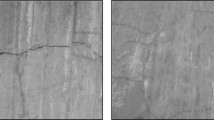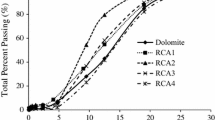Abstract
Cracks reduce the durability and service life of bridge decks and they usually form as a result of tension induced from restrained shrinkage of concrete. There are several mixture design technologies that can be used to reduce concrete shrinkage and subsequent cracking. The main focus of this study is to evaluate the effectiveness of three such technologies to limit restrained shrinkage cracking in a scaled laboratory bridge deck. The first mixture evaluated shrinkage compensating cement (Type-K) as a partial replacement of Portland cement, the second mixture evaluated pre-wetted lightweight fine aggregate as a partial replacement of fine aggregate to promote internal curing (IC), and finally, the third evaluated a mixture incorporating shrinkage reducing admixture (SRA). Strain of the deck reinforcement was monitored during and after placement of the concrete for a period of 6 months. All of the data was compared with similar measurements from a control deck containing a standard concrete mixture used by the Illinois Department of Transportation. The results showed that, the experimental deck containing Type-K cement exhibited around 100% higher expansion compared to control mixture during the curing period. The IC mixture showed approximately 50% less expansion at 7 days but exhibited 10% less shrinkage at the end of drying period compared to the control mixture. The initial expansion of SRA mixture showed similar peak value compared to control mixture but at the end of the drying period, the shrinkage of SRA mixture was around 75% less than the deck cast with control mixture.














Similar content being viewed by others

Availability of data and material
All the materials used in this project have been acquired and used in the analysis of the results based on the funding provided by Illinois Department of Transportation (IDOT).
References
Lindquist WD, Darwin D, Browning J, Miller GG (2006) Effect of cracking on chloride content in concrete bridge decks. ACI Mater J 103(6):467–473
Hadidi R, Saadeghvaziri MA (2005) Transverse cracking of concrete bridge decks: state-of-the-art. J Bridge Eng 10(5):503–510
Whiting DA, Detwiler RJ, Lagergren ES (2000) Cracking tendency and drying shrinkage of silica fume concrete for bridge deck applications. Mater J 97(1):71–77
Altoubat SA, Lange DA (2001) Creep, shrinkage, and cracking of restrained concrete at early age. ACI Mater J 98(4):323–331
Subramaniam KV, Gromotka R, Shah SP, Obla K, Hill R (2005) Influence of ultrafine fly ash on the early age response and the shrinkage cracking potential of concrete. J Mater Civ Eng 17(1):45–53
Issa MA (1999) Investigation of cracking in concrete bridge decks at early ages. J Bridge Eng 4(2):116–124
Richardson D, Tung Y, Tobias D, Hindi R (2014) An experimental study of bridge deck cracking using Type K-cement. Constr Build Mater 52(1):366–374
Nagataki S, Gomi H (1998) Expansive admixtures (mainly ettringite). Cem Concr Compos 20(2):163–170
Chaunsali P, Mondal P (2015) Influence of mineral admixtures on early-age behavior of calcium sulfoaluminate cement. ACI Mater J 112(1):1–10
Chen IA, Hargis CW, Juenger MC (2012) Understanding expansion in calcium sulfoaluminate-belite cements. Cem Concr Res 42(1):51–60
Rahman M, Chen Y, Lindquist W, Ibrahim A, Hindi R (2018) Mitigation of shrinkage cracking in bridge decks using Type-K cement. In: Presented at the structures congress 2018. https://doi.org/10.1061/9780784481332.011
Chaunsali P, Lim S, Mondal P, Foutch DA, Richardson D, Tung Y, Hindi R (2013) Bridge decks: mitigation of cracking and increased durability. Illinois Center for Transportation Series No. 13-023 UILU-ENG-2013-2024, ISSN: 0197-9191
Gartner E (2004) Industrially interesting approaches to “Low-Co2” cements. Cem Concr Res 34(9):1489–1498
Gartner EM, Macphee DE (2011) A physico-chemical basis for novel cementitious binders. Cem Concr Res 41(7):736–749
Sharp J, Lawrence C, Yang R (1999) Calcium sulfoaluminate cements—low-energy cements, special cements or what? Adv Cem Res 11(1):3–13
Chaunsali P, Mondal P (2015) Influence of calcium sulfoaluminate (Csa) cement content on expansion and hydration behavior of various ordinary Portland cement-Csa blends. J Am Ceram Soc 98(8):2617–2624
Odler I, Colán-Subauste J (1999) Investigations on cement expansion associated with ettringite formation. Cem Concr Res 29(5):731–735
Bentur A, Ish-Shalom M (1974) Properties of Type K expensive cement of pure components Ii. Proposed mechanism of ettringite formation and expansion in unrestrained paste of pure expansive component. Cem Concr Res 4(5):709–721
Kasselouri V, Tsakiridis P, Malami C, Georgali B, Alexandridou C (1995) A study on the hydration products of a non-expansive sulfoaluminate cement. Cem Concr Res 25(8):1726–1736
Péra J, Ambroise J (2004) New applications of calcium sulfoaluminate cement. Cem Concr Res 34(4):671–676
Mehta PK, Hu F (1978) Further evidence for expansion of ettringite by water adsorption. J Am Ceram Soc 61(3–4):179–181
Ardeshirilajimi A, Wu D, Chaunsali P, Mondal P (2017) Effects of presoaked lightweight aggregate on deformation properties of ordinary Portland cement-calcium sulfoaluminate cement blends. ACI Mater J 114(4):643–652
Akcay B, Tasdemir MA (2008) Internal curing of mortars by lightweight aggregates and its effects on hydration. Can J Civ Eng 35(11):1276–1284
Bentz DP, Snyder KA (1999) Protected paste volume in concrete: extension to internal curing using saturated lightweight fine aggregate. Cem Concr Res 29(11):1863–1867
Bentz DP, Weiss WJ (2011) Internal curing: a 2010 state-of-the-art review. US Department of Commerce, National Institute of Standards and Technology, Gaithersburg
Espinoza-Hijazin G, Lopez M (2011) Extending internal curing to concrete mixtures with W/C higher than 0.42. Constr Build Mater 25(3):1236–1242
Henkensiefken R, Castro J, Bentz D, Nantung T, Weiss J (2009) Water absorption in internally cured mortar made with water-filled lightweight aggregate. Cem Concr Res 39(10):883–892
Rahman M, Chen Y, Lindquist W, Ibrahim A, Tobias D, Krstulovich J, Hindi R (2018) Large-scale testing of shrinkage mitigating concrete. J Sustain Cem Based Mater 8(1):39–54
Browning J, Darwin D, Reynolds D, Pendergrass B (2011) Lightweight aggregate as internal curing agent to limit concrete shrinkage. ACI Mater J 108(6):638–644
Bentur A, Igarashi S-I, Kovler K (2001) Prevention of autogenous shrinkage in high-strength concrete by internal curing using wet lightweight aggregates. Cem Concr Res 31(11):1587–1591
Bentz DP (2007) Internal curing of high-performance blended cement mortars. ACI Mater J 104(4):408
Wasserman R, Bentur A (1996) Interfacial interactions in lightweight aggregate concretes and their influence on the concrete strength. Cem Concr Compos 18(1):67–76
Folliard KJ, Berke NS (1997) Properties of high-performance concrete containing shrinkage-reducing admixture. Cem Concr Res 27(9):1357–1364
Weiss J, Berke N (2003) Admixtures for reduction of shrinkage and cracking, Early Age Cracking in Cementitious Systems. RILEM TC 181-EAS-Final Report, V. 25 2003, pp 323–335
Arezoumandi M (2015) Feasibility of crack free reinforced concrete bridge deck from materials composition perspective: a state of the art review. Front Struct Civ Eng 9(1):91–103
Lura P, Pease B, Mazzotta GB, Rajabipour F, Weiss J (2007) Influence of shrinkage-reducing admixtures on development of plastic shrinkage cracks. ACI Mater J 104(2):187
Saliba J, Rozière E, Grondin F, Loukili A (2011) Influence of shrinkage-reducing admixtures on plastic and long-term shrinkage. Cem Concr Compos 33(2):209–217
Brown MD, Smith CA, Greg Sellers J, Folliard KJ, Breen JE (2007) Use of alternative materials to reduce shrinkage cracking in bridge decks. ACI Mater J 104(6):629–637
Rongbing B, Jian S (2005) Synthesis and evaluation of shrinkage-reducing admixture for cementitious materials. Cem Concr Res 35(3):445–448
Cheung AK, Leung CK (2011) Shrinkage reduction of high strength fiber reinforced cementitious composites (Hsfrcc) with various water-to-binder ratios. Cem Concr Compos 33(6):661–667
Mehdipour I, Khayat KH (2018) Effect of shrinkage reducing admixture on early expansion and strength evolution of calcium sulfoaluminate blended cement. Cem Concr Compos 92:82–91
Passuello A, Moriconi G, Shah SP (2009) Cracking behavior of concrete with shrinkage reducing admixtures and PVA fibers. Cem Concr Compos 31(10):699–704
Weiss WJ, Yang W, Shah SP (1998) Shrinkage cracking of restrained concrete slabs. J Eng Mech 124(7):765–774
Ardeshirilajimi A, Wu D, Chaunsali P, Mondal P, Chen YT, Rahman MM, Ibrahim A, Lindquist W, Hindi R (2016) Bridge decks: mitigation of cracking and increased durability. Illinois Center for Transportation Series No. 16-018. UILU-ENG-2016-2018, ISSN: 0197-919
Rahman M, Gonzalez D, Hindi R (2019) Combined effect of expansive cement and internal curing to mitigate shrinkage cracking in bridge decks. In: Presented at the structures congress 2019. https://doi.org/10.1061/9780784482230.006
Battaglia IK, Whited G, Swank R (2008) Eclipse® shrinkage reducing admixture product evaluation. Wisconsin Department of Transportation, Technical Services, Madison
ASTM C39/C39M-18, Standard test method for compressive strength of cylindrical concrete specimens, ASTM International, West Conshohocken, PA, 2018. www.astm.org
Acknowledgements
The authors appreciate the assistance of Dr. Paramita Mondal, UIUC; MD Ashiquzzaman, Nick Duong, Martin Fiedler, Darren Green, Faress Hraib, Li Hui and Mehdi Motaleb, Ann Scales, SLU, for their help and contribution throughout this research. The opinions and findings of this paper are those of the authors.
Author information
Authors and Affiliations
Contributions
All the listed authors have contributed to the content and the analysis of the results of the manuscript.
Corresponding author
Rights and permissions
About this article
Cite this article
Rahman, M., Chen, Y., Ibrahim, A. et al. Study of Drying Shrinkage Mitigating Concrete Using Scaled Bridge Bays. Int J Civ Eng 18, 65–73 (2020). https://doi.org/10.1007/s40999-019-00460-z
Received:
Revised:
Accepted:
Published:
Issue Date:
DOI: https://doi.org/10.1007/s40999-019-00460-z



